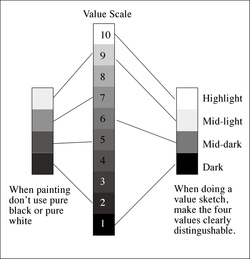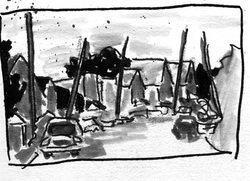 Ask any professional painter and they will tell you that they don't paint objects, scenes or figures, they paint shapes. And to them, shapes are made up of areas of similar value. That is, how dark or light it is. In other words, what makes one shape separate from another shape is its value. There are several value scales going the rounds. Scale of one to ten with ten being white, zero to ten with ten being white. one to ten with ten being black, etc. We're using the one to ten scale with one being black and ten being white. It seems to have won out over the other scales. It's important to know which scale someone is using if they are referring to values, as you can imagine the results of a value of seven will be vastly different depending upon the scale used. You should almost never paint anything either a ten or a one. These things rarely ever occur in nature, although you might use a ten if you were depicting the tiny glint of pure light reflecting off a white or bright metal or glass object. Tiny! Black should next to never be used. In real life, there is no shadow or substance that is pure black. Using pure black is like having a hole in your painting. No light escapes. It's dull. So that leaves values two to nine. Eight values is still too many to easily separate in a scene, and if you do separate a scene into eight values, you will no longer have major shapes. Instead, you will have dozens of little, unconnected shapes, robbing your painting of strength. When you look at a scene, think along the terms of four values, five at most.  Here I've created a "Value Sketch" to help me divide the scene into the four values. While above I said no black and no white, for the purpose of your value sketch, black stands for the darkest values, white for the lightest. They don't stand for black & white. By dividing the scene into these four values, it's so much easier to see the compositional structure. If you cannot make the scene work in this simplified arena, no amount of "fixing" it as you paint will ever make it work as a painting.. The value sketch and the resulting knowledge of where the darks, mid-tones and lights should be, helps you stay honest to the scene as you paint. If it was dark in the sketch, make sure the value is dark in the painting, no matter what the colour. Keith Thirgood www.wilsonstreetstudios.com
1 Comment
|
Keith ThirgoodIs an artist working in the Canadian, post impressionist style. I paint en plein air when I can and in the studio the rest of the time. Archives
June 2019
Categories
All
|
 RSS Feed
RSS Feed
